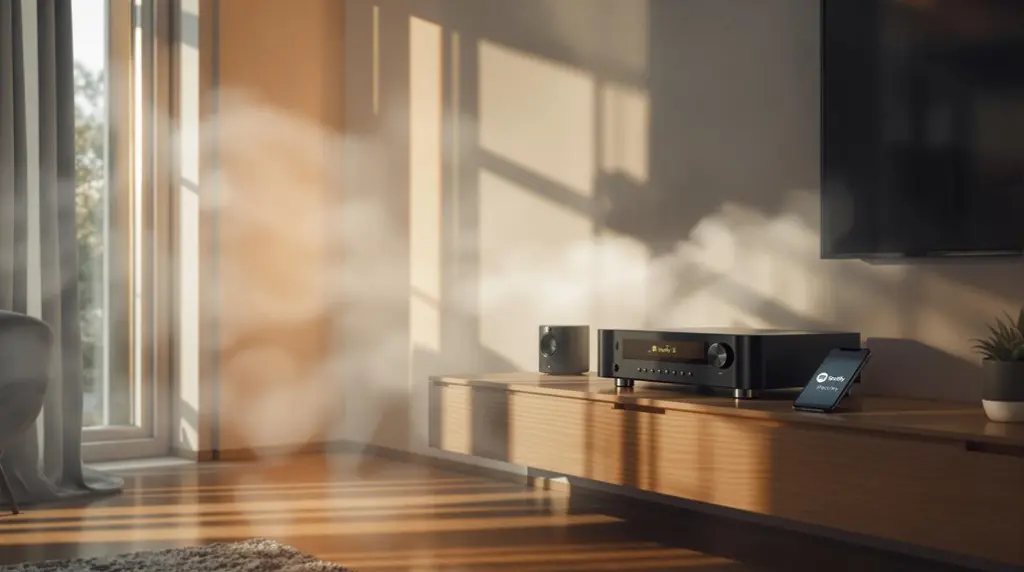Creating the ideal DJ room is an important step for any aspiring DJ, and understanding the fundamentals can make all the difference. From ensuring best speaker placement to elevating your laptop for better ergonomics, the initial setup can greatly impact your performance and comfort. Additionally, meticulous cable management not only enhances aesthetics but also prevents potential hazards. These foundational elements form the backbone of a functional and efficient DJ workspace. To explore how each of these aspects can be effectively implemented and why they matter, let’s examine the essential components in detail.
Key Takeaways
- Position speakers at ear level and direct them towards your head for optimal sound quality.
- Elevate your laptop with an adjustable stand to improve visibility and ergonomics.
- Manage cables using ties and clips to maintain an organized and professional workspace.
- Implement effective cable management to enhance the overall aesthetic of your DJ room.
- Regularly inspect and replace damaged cables to ensure reliable and safe equipment operation.
Optimize Speaker Placement
To achieve superior sound quality in your DJ room, it is vital to position the tweeters at ear level. This strategic placement guarantees that high frequencies reach your ears directly, enhancing clarity and detail. For peak performance, direct the speakers towards your head to maximize the listening experience and improve beatmatching accuracy.
Acoustics consideration is essential in achieving the best sound quality. The interaction between sound waves and the room’s surfaces can have a profound impact on audio fidelity. Sound reflection off walls, floors, and ceilings can result in phase cancellation and standing waves, distorting the sound. As such, experimenting with speaker distance from walls is crucial.
Placing speakers too close to walls can amplify bass frequencies, causing an imbalance in the overall sound. Conversely, positioning them too far can lead to a loss of low-end presence.
Room size also plays a critical role in determining the ideal speaker placement. A smaller room may require a closer arrangement, while a larger room might benefit from more distance between speakers. Precise adjustments to tweeter positioning can greatly enhance sound distribution and performance.
Elevate Your Laptop
Raising your laptop is essential for improving both visibility and accessibility to your DJ software and controls, thereby optimizing your overall performance setup. Utilizing an elevated position for your laptop not only enhances your ability to monitor track progress and manipulate controls efficiently but also reduces neck strain and discomfort by aligning the screen with your natural eye level.
Investing in a foldable laptop stand with adjustable angles offers unparalleled versatility, accommodating various performance environments and ergonomic preferences. The ability to modify the laptop’s angle ensures that you can maintain ideal posture while accessing all necessary features of your DJ software with ease. This adaptability is important for maintaining comfort and precision during prolonged sessions, whether at a gig or in a home studio.
Moreover, raising your laptop aids in effective cable management. By elevating your device, you create additional space underneath, which can be used to organize and route cables systematically. This not only enhances the aesthetic appeal of your setup but also minimizes the risk of accidental disconnections or tangling during a performance. Additionally, improved airflow under the laptop prevents overheating, ensuring reliable operation throughout your sets.
To summarize, raising your laptop is a fundamental step in crafting a professional and efficient DJ workspace.
Manage Your Cables
Enhancing your DJ setup goes beyond laptop elevation; meticulous cable management is paramount for maintaining an organized and efficient workspace. Effective cable organization not only enhances the aesthetic appeal of your setup but also simplifies troubleshooting when technical issues arise.
Utilizing cable ties or clips ensures cables are secured neatly, preventing tangles that can lead to disruptions during performances. Labeling each cable is equally critical, facilitating quick identification and resolution of any connectivity problems.
Safety precautions should be at the forefront of your cable management strategy. Keeping cables away from walkways mitigates the risk of trips and falls, safeguarding both you and your equipment. Implementing cable management solutions like cable sleeves or raceways can provide a cleaner, more professional look while also protecting the cables from physical damage.
Regular maintenance is essential to maintain the longevity and reliability of your cables. Periodically inspecting them for wear and tear can prevent potential hazards or malfunctions that could interrupt your sessions. Replacing damaged cables promptly is important for maintaining an uninterrupted workflow.
Frequently Asked Questions
What Is Needed for a Basic DJ Setup?
A basic DJ setup requires a DJ controller or turntable, laptop with DJ software, headphones, speakers, and cables. Consider soundproofing tips for noise control and explore lighting options to enhance the visual ambiance and performance experience.
What Should I Buy as a Beginner Dj?
As a beginner DJ, invest in a basic DJ controller, beginner-friendly software, studio monitors, and quality headphones. Additionally, optimize room acoustics and consider versatile lighting options to enhance your practice environment and overall performance experience.
What Do I Need to Set up as a Dj?
To set up as a DJ, invest in soundproofing techniques, lighting options, a DJ controller or turntable, a laptop with professional software, studio monitors, headphones, and essential cables. Proper speaker positioning and cable management are crucial for peak performance.
How Does a Beginner DJ Start?
A beginner DJ starts by mastering foundational learning techniques, such as beatmatching and mixing, while exploring diverse music genres. Utilizing online tutorials and practicing consistently are essential for skill development and industry proficiency.
Conclusion
To sum up, the foundation of a functional and efficient DJ room for beginners hinges on three critical elements:
- Optimizing speaker placement to enhance acoustic performance
- Elevating the laptop to improve ergonomics and visibility
- Managing cables to maintain a safe and organized workspace
Mastery of these foundational techniques not only contributes to a more professional setup but also enhances the overall DJing experience, paving the way for skill development and creative expression.




